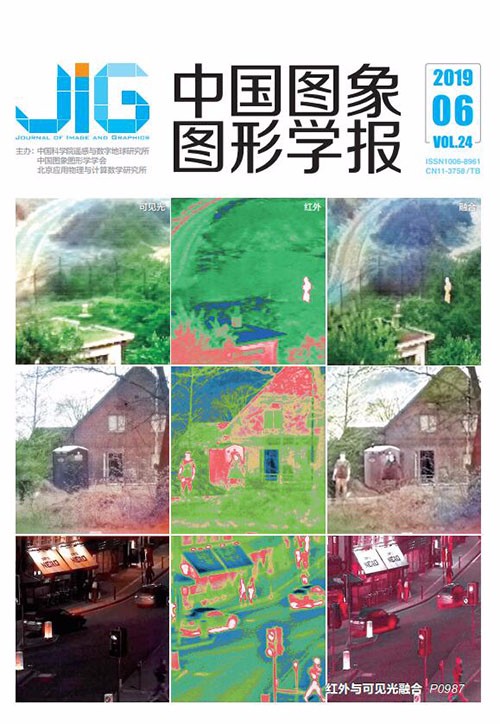
3维灰度矩阵的钢板缺陷图像识别
摘 要
目的 钢板表面缺陷的种类多样、灰度结构复杂,现有的图像分割技术运用在灰度结构复杂、目标边缘模糊的钢板缺陷图像中仍然存在识别效率低、过分割现象明显等问题,本文结合图像灰度矩阵的空间特征,提出一种基于3维灰度矩阵的钢板表面缺陷识别算法。方法 首先根据灰度图像构建3维灰度矩阵;然后引入半类间方差改进克里金插值算法,绘制3维灰度矩阵的等值线图;接着构建等值线的拓扑关系树;最后根据自定义的全局搜索策略和局部搜索策略相结合,寻找局部凹凸区域,从而定位缺陷区域,达到分割钢板表面缺陷的目的。结果 本文方法能有效地识别钢板表面缺陷区域,对光照变化不敏感,在保证低误差率的前提下,提高了有效分割率。通过对氧化、辊印、结疤和气泡四类钢板缺陷图像进行测试,从分割效果和评价指标两方面对比其他钢板缺陷分割算法。与Fisher阈值分割法、经典的活动轮廓模型CV模型、基于半局部区域描述符的活动轮廓模型HTB模型和改进背景差分法进行分割效果对比,本文方法对四类钢板表面缺陷的识别更精确,分割结果更细致,一定程度上抑制了过分割现象。与大津法Ostu、1维最大模糊熵法1DMFE、最大模糊超熵法MFEE进行评价指标对比,得出对于分割孔洞和辊印图像,本文方法在误分割率均保持在2.0%以下的前提下,将有效信息率分别提升了1.6%和2.1%;对于夹杂图像,本文方法在3.4%的误分割率的前提下,具有85%以上的有效信息率。结论 提出的基于3维灰度矩阵的钢板缺陷图像识别算法可以有效地识别多种类型的钢板缺陷,即使在缺陷结构复杂的图像识别中仍具有较高的识别率。
关键词
Image recognition of steel plate defects based on a 3D gray matrix
Lan Hong, Fang Zhiyu(College of Information Engineering, Jiangxi University of Science and Technology, Ganzhou 341000, China) Abstract
Objective Steel plate is an indispensable raw material in machinery manufacturing, automobile production, aerospace, and shipyard manufacturing. Its surface quality directly affects the performance and quality of final products. In an actual steel plate production line, various defects often occur on the surface of the steel sheet due to various processing factors, such as imperfect processing technology and aging of equipment components. Owing to the variety of surface defects and the complex gray structure, if the existing image segmentation technology is applied to a steel plate defect image with a complex gray structure and blurred target edge, then low recognition efficiency, obvious over-segmentation, and other issues will arise. In this study, we analyze the spatial characteristics of the gray matrix of a steel plate defect image and find that transforming a two-dimensional image gray matrix into 3D space can help us identify the defect position of the steel plate surface. Therefore, we propose a steel surface defect recognition algorithm based on the 3D gray matrix. Method First, the 2D gray image of the steel plate's surface defect image is obtained and transformed into a 3D gray matrix using the matrix transformation algorithm. The transformed matrix is drawn in a 3D space, and the local concave and convex portions are identified, that is, the position of the defect corresponding to the surface of the steel sheet. Second, the kriging space interpolation algorithm is used to process the transformed 3D matrix. The kriging algorithm is derived from geostatistics; therefore, to make the method suitable for processing image data, this study introduces semi-class variance to improve the Kriging interpolation algorithm. A contour map of the 3D gray matrix is thus drawn. Third, after obtaining the contours corresponding to the 3D matrix, we use the position principle between the points and curves to construct a topological relationship tree of the contours and determine the inclusion relationship between the contours. Finally, according to the combination of customized global and local search strategies, the local concave and convex areas are searched to locate the defect area and achieve the purpose of dividing the surface defects of the steel plate. Result Our method can effectively identify the surface defect area of the steel plate, is not sensitive to illumination change, and improves the effective division rate under the premise of ensuring a low error rate. Fisher's threshold segmentation method (FT), classical CV model (CV), HTB model (HTB), and improved background difference method (ABDM) are compared. For the FT algorithm based on edge information and the Fisher criterion, a fixed single threshold is selected, which can effectively segment an image with a large defect area and obvious difference with background grayscale. However, distinguishing the surface defect of the steel plate effectively is difficult when the target is similar to the grayscale of the background. For the CV model, image segmentation with a complex structure is inaccurate, and the number of iterations is large. The method of processing the four types of defect images has over-segmentation. This method cannot cope with the image segmentation task under boundary blur conditions. The HTB model solves the problem that the CV model cannot, that is, to adapt to the grayscale uneven image segmentation problem. However, regardless of the good segmentation effect on the knotted defect image, the algorithm has a poor segmentation effect on the other three types of defects. The ABDM algorithm, which aims to improve the background difference, requires that the constructed background model be as suitable as possible for the foreground image; therefore, the segmentation effect of the steel plate defect image that has a large defect target region is poor. In this study, the 3D gray matrix of the image is used to realize localization and segmentation of the defect region. The proposed algorithm can obtain accurate segmentation results for defect target extraction of the four types of defect images. Compared with Otsu, 1DMFE, and MFEE in terms of segmentation of the hole and roll image, our method improves the effective information rate by 1.6% and 2.1%, respectively, under the premise of ensuring that the mis-segmentation rate is kept below 2.0%. For the inclusion image, our method has an effective information rate of more than 85% under the premise of 3.4% mis-segmentation rate. Conclusion By transforming a 2D grayscale image into a 3D gray matrix, we analyze the characteristics of the grayscale image in 3D space and find that the defect area on the surface of the steel plate image corresponds to the local unevenness of the 3D space. Thus, a method based on an image segmentation algorithm for steel plate surface defects in a 3D gray matrix is proposed. First, a 3D gray matrix is generated from the original gray image. Second, a gray contour map is drawn. Third, the relationship between contours is determined, and a contour topological relationship tree is constructed. Finally, the contour is traversed according to a search strategy, the local concave and convex regions are identified, and the target position is determined to achieve segmentation. Experimental results show that the proposed algorithm can effectively segment common steel plate defects with uneven grayscale. From qualitative and quantitative perspectives, the algorithm can quickly and effectively extract defect regions in a steel plate image. In summary, the proposed steel plate defect image recognition algorithm based on a 3D gray matrix can effectively identify many types of steel plate defects, even in image recognition with a complex defect structure.
Keywords
steel surface defect identification three-dimensional gray matrix Kriging interpolation algorithm gray contour topological relationship tree
|



 中国图象图形学报 │ 京ICP备05080539号-4 │ 本系统由
中国图象图形学报 │ 京ICP备05080539号-4 │ 本系统由